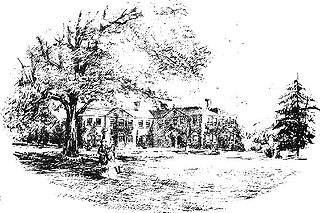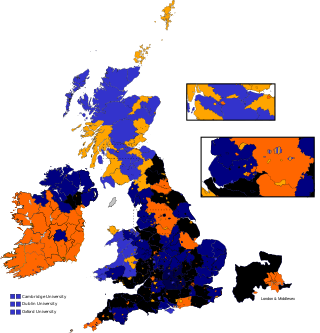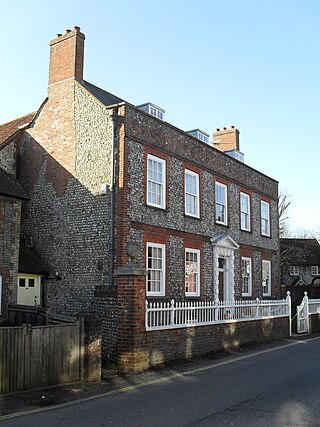
Rye is a town and civil parish in the Rother district of East Sussex, England, two miles from the sea at the confluence of three rivers: the Rother, the Tillingham and the Brede. An important member of the mediaeval Cinque Ports confederation, it was at the head of an embayment of the English Channel, and almost entirely surrounded by the sea.

Winchelsea is a town in the county of East Sussex, England, located between the High Weald and the Romney Marsh, approximately 2 miles (3.2 km) south west of Rye and 7 miles (11 km) north east of Hastings. The current town, which was founded in 1288, replaced an earlier town of the same name, known as Old Winchelsea, that was lost to coastal erosion in the late medieval period. Winchelsea is part of the civil parish of Icklesham.

St Leonards-on-Sea is a town and seaside resort in the Borough of Hastings in East Sussex, England. It has been part of the borough since the late 19th century and lies to the west of central Hastings. The original part of the settlement was laid out in the early 19th century as a new town: a place of elegant houses designed for the well-off; it also included a central public garden, a hotel, an archery, assembly rooms and a church. Today's St Leonards has extended well beyond that original design, although the original town still exists within it.

Horsham is a constituency represented in the House of Commons of the UK Parliament, centred on the eponymous town in West Sussex, its former rural district and part of another rural district. Its Member of Parliament (MP) was Francis Maude between 1997 and 2015; followed by Jeremy Quin, both of the Conservative Party, until 2024 when the seat was won from the Conservative MP Quin by John Milne of the Liberal Democrats, making it the first time since 1876 that a non-Conservative Party candidate won the seat.

The County Cricket Ground, known for sponsorship reasons as The1st Central County Ground, is a cricket venue in Hove, in the city of Brighton and Hove, East Sussex, England. The County Ground is the home of Sussex County Cricket Club, where most Sussex home matches since 1872 have been played, although many other grounds in Sussex have been used. Sussex CCC continue to play some of their games away from The County Ground, at either Arundel Castle or Horsham. It is one of the few county grounds to have deckchairs for spectators, in the Sussex CCC colours of blue and white, and was the first cricket ground to install permanent floodlights, for day/night cricket matches and the second ground to host a day/night match in England, in 1997.
Hastings was a parliamentary constituency in Sussex. It returned two Members of Parliament to the Parliament of England until 1707, Parliament of Great Britain before 1801 and the House of Commons of the Parliament of the United Kingdom until the 1885 general election, when its representation was reduced to one member. It was abolished for the 1983 general election, when it was partially replaced by the new Hastings and Rye constituency.

Thornbridge Hall is a large English country house situated near the village of Great Longstone in the local government district of Derbyshire Dales in Derbyshire. It is a Grade II listed building.
Rye was a parliamentary constituency centred on the town of Rye in East Sussex. It returned two Members of Parliament to the Parliament of England before 1707, Parliament of Great Britain until 1801 and the House of Commons of the Parliament of the United Kingdom until its representation was halved under the Reform Act 1832.
Dodington Park is a country house and estate in Dodington, South Gloucestershire, England. The house was built by James Wyatt for Christopher Bethell Codrington. The family had made their fortune from sugar plantations in the Caribbean and were significant owners of slaves. It remained in the Codrington family until 1980; it is now owned by the British businessman James Dyson.

East Sussex was a parliamentary constituency in the county of Sussex, which returned two Members of Parliament to the House of Commons of the Parliament of the United Kingdom, elected by the bloc vote system.
Blackfriars, Winchelsea, was a Dominican priory in Winchelsea, East Sussex, England. The friary was established in 1318 by Edward II on the outskirts of the new town of Winchelsea, but after several moves to different locations, was granted in 1358 a site of an acre with five adjoining houses in the town centre. It was dissolved in 1538, at which point the building was ruinous. As with other dissolved religious houses in Winchelsea, the stone of the structures was used for the construction of Camber Castle.

The Derby Tramways Company operated horse-drawn tramway services in Derby, England from 1880 to 1904.

Strand House was the Parish Workhouse of the Sussex town of Winchelsea known as the "Old Poor Houses". It was located on The Strand.

Tyes Place is a listed historic manor house in Staplefield, West Sussex, England. It was once a farm, then in the first half of the 20th century it was owned by local benefactors Margaret and Stanley Powell, who in 1918 used the building as a rest house for clergy. It is now a private residence.
The Court House is a grade I listed house in Hale Lane, Painswick, Gloucestershire, England, within the Cotswolds.

Wadhurst Castle is a 19th-century castellated mansion just to the west of the town of Wadhurst, East Sussex, England, in an elevated position overlooking the countryside to the south. It is a grade II listed building.

Southdown House is a Grade II* listed building in Patcham, Brighton and Hove, England. It is a Georgian house made out of brick and flint, and is now situated at 51 Old London Road.

Langton Dennis ARIBA was an architect based in England who is best known for his domestic houses in the Arts and Crafts style in Crowborough, Sussex.

Barnham Court is a 17th-century Artisan Mannerism house in Barnham, West Sussex, England. It is a Grade I listed building, and has many features similar to Kew Palace in London.
(Julia) Maud Peel (1843-1939) was an artist based in England.















